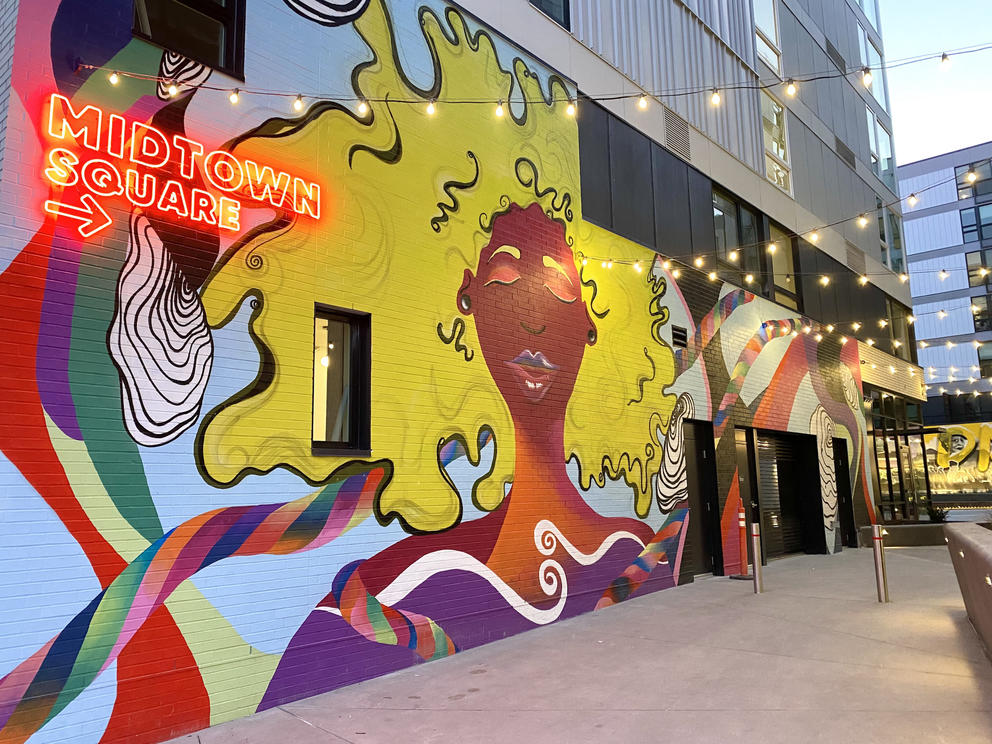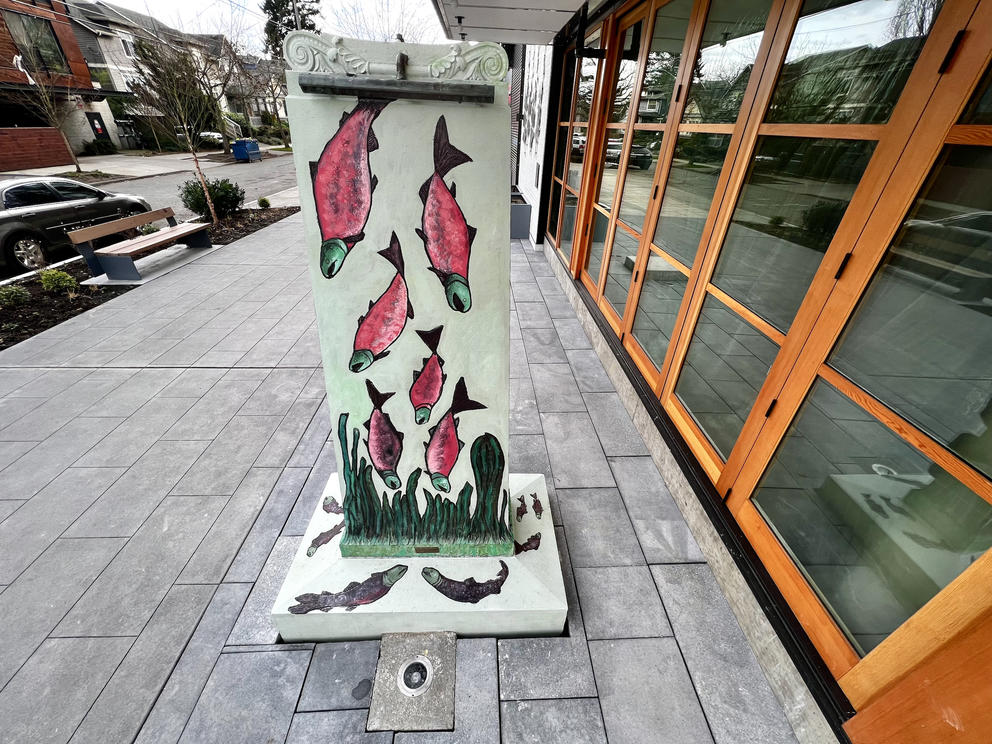Arriving at my regular stoplight has become more enjoyable with each new art installation that has appeared — Barry Johnson’s colorful jazz abstraction, Adam Jabari Jefferson’s collage of smiling neighborhood faces, Myron Curry’s vivid portraits of famous Seattle figures. So last weekend, when I saw that the construction fences had come down, I pulled over to take a closer look.
ArtSEA: Notes on Northwest Culture is Crosscut’s weekly arts & culture newsletter.
Just in time for Black History Month, the site has come alive with art in homage to the prominent African American artists and cultural workers of Seattle’s past.
At the eastern entrance, Perri Rhoden’s exuberant and swirling mural — with its appealing smattering of oyster shells — pulled me into the central plaza. There, my eyes jumped to the huge mural by local artist Takiyah Ward (organizer of the Black Lives Matter mural on Capitol Hill, who just launched a new art talk show on Converge Media called Art of the Matter). Interspersed among the balloony letters that spell CENTRAL DISTRICT are the faces of people like hotelier/restaurateur William Grose, curator Zoë Dusanne and the Rev. Dr. Samuel B. McKinney.
The western entrance to the square is adorned with a doubled string of lit lanterns, a collaborative project by sculptor Henry Jackson-Spieker and KT Hancock. On each of the 16 lanterns is an image depicting an artist from Seattle’s Black past — singer Ernestine Anderson, photographer Al Smith, pianist Ruby Bishop, painter Jacob Lawrence — all people who lit the path for those who came after them.
In addition to being attractive, it’s a clever installation that tests your knowledge (how many artists can you identify by their faces alone?), prompts you to learn more and physically engages each viewer in the act of looking up to these trailblazers.
At the northeast corner of the Midtown project is a piece of historic art: the reinstallation of James Washington Jr.’s “Fountain of Triumph.” The prominent Seattle painter and sculptor was part of the Northwest School of artists during the 1930s and 1940s and contributed some five decades of artistic influence in the region (he died in 2000).
Washington’s minimalist yet emotive small animals carved of stone, including flocks of understated birds tucked into their feathers, are nationally recognized and included in several local museum collections, including at the Seattle Art Museum. You can see two of his evocative stone works — a bird and a woodchuck, each nestled into driftwood — in the new show Departures and Divisions: Variation in American Style, 1900-1950 at the Tacoma Art Museum (through Sept. 4).
“Fountain of Triumph” was first installed at 23rd and Union in 1994, having been commissioned by the Bangasser family, who originally owned the property. The vertical sculpture depicts salmon swimming directly upstream as a metaphor for the struggles of African Americans. It has been carefully restored by Sabah Al-Dhaher of Pratt Fine Arts Center, thanks to the James Washington Jr. and Janie Rogella Washington Foundation and developer Lake Union Partners. The piece was once again splashing with water when I stopped by.
Midtown Square is still coming into full bloom, with several Black-owned businesses set to open on the ground floor, including Arté Noir, a new space for Black arts and culture, under the direction of local arts maven Vivian Phillips. Immediately to the south of the complex will be the Africatown Plaza, which will hold an online celebration for its real-life groundbreaking this weekend (Feb. 5, noon-2 p.m.). Once this neighboring affordable housing development is completed, it, too, will be a cultural destination with multiple art installations.
And in a couple of weeks, the current generation of Black artists will publicly honor an elder, by way of a new sculpture of James Washington Jr. Artist Barry Johnson spent two years working with the James Washington Jr. Foundation and the Midtown project planners to design a 6-foot-tall likeness, which he had cast in bronze in Oregon. He’ll unveil the piece at a celebration on Feb. 26 (6:30-8:30 p.m. at Midtown Square). In the sculpture, Washington holds one of his signature stone birds in both hands, as if supporting the small spirit until it can take flight.
Michael Spafford — another massive force in the shaping of Seattle’s artistic landscape — passed away on Jan. 29 at the age of 86. Spafford influenced countless artists during his 30-plus years as a professor at the University of Washington, and made an indelible impact over a 60-year career with his own paintings, woodblock prints and public works.
In 2018, Crosscut contributor Michael Upchurch interviewed Spafford on the occasion of Epic Works, an expansive retrospective of his artwork held across Greg Kucera, Woodside/Braseth and Davidson galleries. In the interview, Spafford’s frank, funny, down-to-earth personality is on display as the two discuss his longtime interest in capturing the labyrinths and labors of Greco-Roman mythology.
Many of his stark silhouettes feel archetypical themselves, bold geometric forms with the distinct scent of human effort, whether the subjects are warring, swimming, shoveling or falling — the last of which can be seen in the huge piece “Tumbling Figure: Five Stages,” installed on the outside of the King County parking garage downtown.
In honor of old-school Seattle arts influencers like Spafford and Washington, get out there and see some locally created art this weekend. Consider: Carol Rashawnna Williams, whose The 1 Million — Multiple Species Eradication at ARTS at King Street Station features delicate fabric monoprints that resonate with the heavy realities of animal extinction; Klara Glosova, whose blurry and personal paintings at Linda Hodges Gallery reflect the banal moments that color our home life; or Barry Johnson (yes, he is everywhere!), whose Pretty Boy Barry, a new installation of paintings in the A Gallery space at Integrus Architecture on Occidental Square, reveals a Seattle artist on the rise.
Get the latest in local arts and culture
This weekly newsletter brings arts news and cultural events straight to your inbox.






